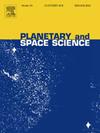Directional Analysis of Fractures at ESA’s Rosalind Franklin landing site, Oxia Planum, Mars
IF 1.7
4区 物理与天体物理
Q3 ASTRONOMY & ASTROPHYSICS
引用次数: 0
Abstract
The Rosalind Franklin rover of the European Space Agency’s ExoMars program is going to land at Oxia Planum, Mars after its launch scheduled in 2030. The mission aims to look for evidence of past and present life on Mars. The presence of fractured rocks at the landing site is of interest to the astrobiological goal of the mission because fractures represent conduits that could facility circulation of fluids. Our study is devoted to observing the orientations of the fractures and to investigate their possible origin by single or multiple processes. We first selected 50 regions of interest (ROIs) in areas of pronounced fracturing, using images from the High-Resolution Imaging Science Experiment (HiRISE) as a basemap. We then analysed the orientation of the fractures and how it varied with length. Statistical analysis shows that fractures predominantly have an E-W orientation, especially in longer fractures, while shorter fractures have a more random pattern. These orientation trends suggest a geological history influenced primarily by both hydrofracturing and tectonic processes. The preferred orientation, which is consistent with north-south tectonic shortening structures documented in the vicinity of the region, is likely to reflect a regional tectonic event between 3.7 and 4.0 billion years ago. The origin of the fractures may have promoted the migration of subsurface fluids through the fractured bedrock, potentially creating habitable conditions for microbial life. Our first study on fractures supports other studies on the geology of the ancient terrains at Oxia Planum, which hides a complex geologic history needing to be unravelled from different perspectives.
欧空局罗莎琳德·富兰克林着陆点火星氧平原断裂的定向分析
欧洲航天局ExoMars计划的罗莎琳德·富兰克林漫游者计划在2030年发射后降落在火星上的氧平原。该任务旨在寻找火星上过去和现在存在生命的证据。着陆点岩石断裂的存在与该任务的天体生物学目标有关,因为断裂代表了可以促进流体循环的管道。我们的研究致力于观察裂缝的方向,并探讨其可能的单一或多重作用的起源。我们首先使用高分辨率成像科学实验(HiRISE)的图像作为底图,在明显压裂区域选择了50个感兴趣区域(roi)。然后我们分析了裂缝的方向以及它如何随长度变化。统计分析表明,裂缝以东西向为主,特别是长裂缝,而短裂缝的分布更具有随机性。这些取向趋势表明地质历史主要受水力压裂和构造作用的影响。优选方向与邻近地区记录的南北构造缩短结构一致,可能反映了37 - 40亿年前的区域性构造事件。裂缝的起源可能促进了地下流体通过裂缝基岩的迁移,潜在地为微生物生命创造了适宜的条件。我们对裂缝的第一项研究支持了对氧气平原古代地形地质的其他研究,它隐藏了一个复杂的地质历史,需要从不同的角度来解开。
本文章由计算机程序翻译,如有差异,请以英文原文为准。
求助全文
约1分钟内获得全文
求助全文
来源期刊

Planetary and Space Science
地学天文-天文与天体物理
CiteScore
5.40
自引率
4.20%
发文量
126
审稿时长
15 weeks
期刊介绍:
Planetary and Space Science publishes original articles as well as short communications (letters). Ground-based and space-borne instrumentation and laboratory simulation of solar system processes are included. The following fields of planetary and solar system research are covered:
• Celestial mechanics, including dynamical evolution of the solar system, gravitational captures and resonances, relativistic effects, tracking and dynamics
• Cosmochemistry and origin, including all aspects of the formation and initial physical and chemical evolution of the solar system
• Terrestrial planets and satellites, including the physics of the interiors, geology and morphology of the surfaces, tectonics, mineralogy and dating
• Outer planets and satellites, including formation and evolution, remote sensing at all wavelengths and in situ measurements
• Planetary atmospheres, including formation and evolution, circulation and meteorology, boundary layers, remote sensing and laboratory simulation
• Planetary magnetospheres and ionospheres, including origin of magnetic fields, magnetospheric plasma and radiation belts, and their interaction with the sun, the solar wind and satellites
• Small bodies, dust and rings, including asteroids, comets and zodiacal light and their interaction with the solar radiation and the solar wind
• Exobiology, including origin of life, detection of planetary ecosystems and pre-biological phenomena in the solar system and laboratory simulations
• Extrasolar systems, including the detection and/or the detectability of exoplanets and planetary systems, their formation and evolution, the physical and chemical properties of the exoplanets
• History of planetary and space research
 求助内容:
求助内容: 应助结果提醒方式:
应助结果提醒方式:


